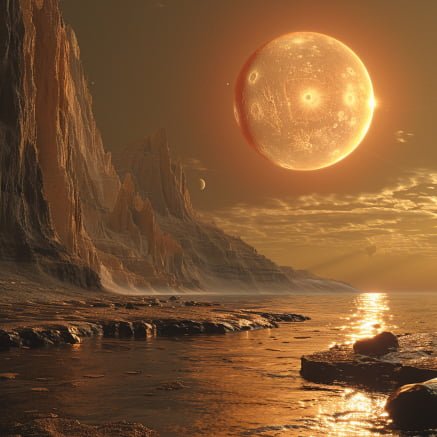Why is Venus Hotter Than Mercury?
When considering the hierarchy of temperatures among the celestial bodies within our solar system, Venus intriguingly clinches the title of the hottest planet, surpassing Mercury, which orbits closer to the Sun. This phenomenon can be perplexing at first glance since one would naturally expect the planet closest to the Sun to boast the highest temperatures. However, the explanation behind Venus being hotter than Mercury lies in a complex interplay of atmospheric conditions, chemical compositions, and solar interactions. This article delves into the various scientific reasons explaining why Venus, despite its distance from the Sun, maintains a warmer climate than Mercury, firmly holding its position as the hottest planet in our solar system.
What Makes Venus Hotter Than Mercury Despite Its Proximity to the Sun?

Understanding the Role of Venus’s Dense Atmosphere
The thick atmosphere of Venus plays a pivotal role in its high surface temperatures. Composed predominantly of carbon dioxide, a potent greenhouse gas, Venus’s atmosphere efficiently traps solar energy, preventing it from radiating back into space. This greenhouse effect on Venus is exponentially stronger than on Earth, resulting in mean temperatures that can melt lead.
Comparing the Atmospheres of Venus and Mercury
Mercury, by contrast, is practically bereft of atmosphere. This means that Mercury has no medium to trap solar energy, allowing heat to escape as quickly as it accumulates during the day. At night, without an atmosphere to retain the heat, temperatures on Mercury plummet, creating extreme temperature fluctuations. Venus’s dense atmosphere, in comparison, acts as a thick blanket, continuously trapping and retaining solar energy.
The Significance of Solar Position in Planetary Temperatures
While Mercury’s proximity to the Sun does result in considerable solar radiation reaching its surface, the absence of an atmosphere for trapping that heat means Mercury does not retain solar energy. Venus’s orbit, though further from the Sun than Mercury’s, benefits from its atmosphere’s ability to trap and maintain solar energy, making Venus hotter than Mercury despite the greater distance from the Sun.
How Does the Greenhouse Effect Contribute to Venus Being the Hottest Planet?
Explaining the Greenhouse Effect on Venus
The greenhouse effect on Venus is a process where solar energy passes through the atmosphere but cannot radiate back into space due to the thick layer of carbon dioxide gas enveloping the planet. This effect substantially increases the surface temperature of Venus, establishing it as the hottest planet in the solar system.
The Role of Carbon Dioxide in Venus’s Temperature
Carbon dioxide, making up about 96% of Venus’s atmosphere, is the primary greenhouse gas responsible for its high temperatures. It efficiently absorbs and traps heat, a characteristic that magnifies the greenhouse effect on the planet. Consequently, the temperature of Venus soars, reaching levels unmatched by any other planet in our solar system.
Comparison with Earth’s Greenhouse Effect
Earth also experiences the greenhouse effect, but it is relatively moderate and life-supporting compared to Venus. The balance of greenhouse gases like carbon dioxide on Earth allows for a habitable climate, whereas the excessive concentration on Venus leads to extreme heating. This stark difference outlines the importance of atmospheric composition in determining a planet’s climate and temperature.
Exploring the Composition of Venus’s Atmosphere

The Dominance of Carbon Dioxide Gas in Venus’s Atmosphere
The atmosphere of Venus is heavily dominated by carbon dioxide, a thick blanket that creates a runaway greenhouse effect. This dense atmospheric composition is the primary reason Venus has the highest mean temperature of any planet in our solar system.
Other Gases Present in Venus’s Atmosphere and Their Impact
Besides carbon dioxide, Venus’s atmosphere also contains traces of nitrogen, sulfur dioxide, and water vapor, which contribute to its overall density and ability to trap heat. These gases play a supporting role in enhancing the greenhouse effect, further elevating Venus’s surface temperature.
How the Thickness of Venus’s Atmosphere Affects Its Temperature
The sheer thickness of Venus’s atmosphere ensures that heat is not only trapped but also distributed evenly across the planet. This results in a stable, albeit scorching, global temperature, unlike the fluctuating conditions seen on planets with thinner atmospheres, such as Mercury.
Why is Mercury Not as Hot as Venus Despite Being Closer to the Sun?
Lack of a Significant Atmosphere on Mercury
Mercury’s status as the closest planet to the Sun does not spare it from cold nights, primarily due to its almost non-existent atmosphere. This lack of atmospheric insulation allows temperatures to spike during the day but plummet at night, leading to the planet’s inability to maintain consistent warmth.
The Role of Albedo in Reflecting Solar Energy
Mercury’s surface, covered in bright, reflective materials, possesses a high albedo, meaning it reflects a significant portion of the sun’s rays back into space. This reflective capability contributes to Mercury’s temperature moderation, in sharp contrast to Venus’s heat absorption and retention.
Comparative Analysis of Day and Night Temperatures on Mercury
The temperature variations between day and night on Mercury are extreme due to its lack of atmosphere—soaring heat during the day and freezing cold at night. Venus, with its thick, blanket-like atmosphere, maintains a consistently oppressive heat, further distinguishing the two planets‘ temperature dynamics.
Investigating the Historical and Future Temperatures of Venus

The Evolution of Venus’s Atmosphere and Its Impact on Temperature
Historically, Venus may have had conditions similar to Earth before experiencing a runaway greenhouse effect. This transformation drastically increased its temperatures, suggesting a volatile climatic history that has implications for understanding planetary evolution.
Predictions on the Future Climatic Conditions of Venus
As research continues, predictions about Venus’s climatic future remain speculative. However, understanding its past and current atmospheric conditions offers valuable insights into potential changes, highlighting the importance of monitoring Venus as a case study in planetary climatology.
Comparative Study of Venus’s Temperature with Other Planets in the Solar System
Venus stands out as an extreme example of the greenhouse effect in our solar system. A comparative analysis with the Earth and Mars, for instance, shows the varying impacts of atmospheric composition on planetary temperatures, underscoring the delicate balance required to sustain habitable conditions.

Q: Why is Venus considered the hottest planet in the solar system?
A: Venus is regarded as the solar system’s hottest planet due to its thick atmosphere, which is rich in carbon dioxide and clouds of sulfuric acid. This dense atmosphere traps heat through a greenhouse effect, leading to surface temperatures high enough to melt lead. This phenomenon, coupled with the fact that Venus’ atmosphere prevents the heat from escaping into space, makes it hotter than Mercury, despite Mercury being closer to the Sun.
Q: How does the atmosphere make Venus hotter than Mercury, though Mercury is closer to the Sun?
A: The key difference lies in their atmospheres. Mercury has no significant atmosphere to trap heat, resulting in drastic temperature fluctuations between day and night. Venus, on the other hand, has a very thick atmosphere composed mainly of carbon dioxide, with clouds of sulfuric acid, creating an intense greenhouse effect. This atmosphere traps solar radiation and keeps the energy from the Sun close to the planet’s surface, leading to consistently high temperatures.
Q: What role does Venus’ position as the second planet from the Sun play in its temperature?
A: As the second planet from the Sun, Venus receives a large amount of solar radiation. However, its distance is not the primary reason for its high temperatures. The critical factor is Venus’ thick atmosphere, which efficiently traps solar radiation and the heat that Venus gets from the Sun. This trapping of heat is more effective on Venus than its slightly farther position from the Sun would suggest.
Q: How do the greenhouse gases in Venus’ atmosphere contribute to its status as the hottest planet in the solar system?
A: The greenhouse gases in Venus’ atmosphere, particularly carbon dioxide, play a crucial role in its extreme temperatures. These gases absorb infrared radiation from the Sun and then radiate the heat back towards the planet’s surface, effectively trapping the heat. This process prevents the heat from radiating away from the planet into space, thus maintaining Venus as the solar system’s hottest planet.
Q: Why doesn’t Mercury’s proximity to the Sun make it hotter than Venus?
A: Mercury’s proximity to the Sun does make it receive more direct solar radiation. However, Mercury has no atmosphere to trap this heat, allowing it to quickly dissipate into space. As a result, temperatures on Mercury can swing to extremely cold levels during its night. In contrast, Venus has a thick atmosphere that captures and retains heat, leading to much higher temperatures despite being further away from the Sun.
Q: Could the composition of Venus’ atmosphere be the reason for its high heat?
A: Absolutely. The composition of Venus’ atmosphere is primarily carbon dioxide, a potent greenhouse gas, along with clouds containing sulfuric acid. This composition is highly effective at trapping heat through the greenhouse effect, making Venus’ atmosphere incredibly efficient at keeping the planet’s surface hot. This is the principal reason why Venus maintains its status as the solar system’s hottest planet.
Q: How does the slow rotation of Venus affect its temperature?
A: The slow rotation of Venus contributes to its extreme temperatures in a couple of ways. First, it causes very long days and nights, lasting about 117 Earth days. This long duration allows the surface of Venus to absorb and trap a significant amount of solar radiation during the day. Moreover, despite the lengthy nights, the thick atmosphere ensures the heat doesn’t escape easily, contributing to the even distribution of temperature and maintaining the planet’s high heat levels consistently.
Q: Is the heat on Venus uniformly distributed across its surface?
A: Yes, the heat on Venus is fairly uniformly distributed across its surface. This uniformity is due to the dense atmosphere’s ability to circulate heat efficiently around the planet. Despite Venus’ slow rotation, the thick atmosphere moves the heat around, minimizing temperature variations and ensuring the surface of Venus remains the solar system’s hottest, with temperatures remaining consistently lethal everywhere on the planet.























